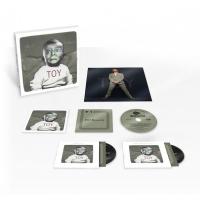On Toy, David Bowie Energetically Revisits His Distant Past
Available in the recent Brilliant Adventure [1992-2001] box set or as the standalone 3CD or 6x10” Toy:Box, Toy is the latest in the Bowie estate and Parlophone’s long, inconsistent posthumous release series, which ranges from excellent archival live albums like Cracked Actor (Live Los Angeles ’74), I’m Only Dancing (The Soul Tour ’74), and Welcome To The Blackout (Live London ’78) to the Live In Berlin [1978] LP mastered at the wrong speed (probably due to a tape issue that no one bothered to fix), cash-grab “copyright collection” 7” box sets of Space Oddity-era demos, mediocre remasters of the core catalog (including the particularly atrocious A New Career In A New Town [1977-1982] box set), and unnecessary colored vinyl and picture disc represses of said unwanted remasters. Regarding known unreleased albums, the Who Can I Be Now? [1974-1976] box set housed 1974’s The Gouster, but that merely assembled previously released outtakes and alternate mixes (it was based on Bowie’s early tracklist sent to producer Tony Visconti, yet left those sessions’ wealth of unreleased material untouched).
Toy’s history is a bit of a confusing mess, and it’s still unclear if Parlophone’s release mimics Bowie’s original intent. Sure, this new release carries his self-designed original cover art, but it omits the previously leaked “Uncle Floyd” and “Afraid” (both finished for Heathen, with the former becoming “Slip Away”), and relegates “Liza Jane” to bonus track status. Further, Parlophone’s release uses Mark Plati’s 2021 mix, which differs from these tracks’ Visconti mixes previously released as Heathen B-sides or on the 2014 Nothing Has Changed compilation (and included on this set’s second disc). It’s unknown if Toy was even properly mixed or fully assembled in 2001, which only clouds certainty of this release’s ideological authenticity. Still, it’s good to hear proper, official mixes of these songs, as the 2011 leak was at best a rough monitor mix.
Unlike David Bowie’s best work, Toy’s sound isn’t particularly unique or groundbreaking, nor are its songs very profound (some lyrics even border on juvenile, but for these 60s compositions that’s not unexpected). Rather, it’s his energy that makes it special, starkly contrasting the preceding Hours’ bland, introspective musings about mortality. Over Toy’s 50-minute duration, Bowie adds to these songs as much maturity and perspective as possible; he retains the 60s charm but lets his excellent backing band and the fresher production elevate them to their full potential.
While heavy on the musically and lyrically simple rockers—among them “I Dig Everything,” “You’ve Got A Habit Of Leaving,” “Let Me Sleep Beside You,” and “Can’t Help Thinking About Me”—Toy still incorporates some variety. “Conversation Piece,” a Space Oddity-era B-side, originally hinted at the storytelling developed on The Man Who Sold The World and Hunky Dory, and here showcases Bowie’s dramatic vocal nuance. The Ziggy Stardust outtake “Shadow Man,” whose original recording remains unreleased (but often bootlegged), is a string-laden ballad narrative-wise acting as one of that album’s deleted scenes. A looser, dreamier song that sprung from “I Dig Everything,” the then-new “Toy (Your Turn To Drive)” closes the album with a certain wistfulness, and is one of Bowie’s most understated yet excellent later tracks.
Despite its highlights, though, Toy is somewhat inconsistent. “Hole In The Ground,” “Baby Loves That Way,” and “Karma Man” are relatively forgettable, “Silly Boy Blue” leans at the end towards sappy, and as the record goes on, some of the songs feel a bit same-y (“Let Me Sleep Beside You” and “Can’t Help Thinking About Me,” while both very good, sound a tad too similar). Of course, Bowie’s next move, Heathen, was one of several late career highlights, its original compositions eloquently expressing the art rock veteran’s post-9/11 fears alongside a handful of carefully considered covers. In the context of Hours and Heathen, Toy appears as the album that reinvigorated Bowie, a vehicle to reflect on his distant past while simultaneously moving forward. It’s a step above Hours but not as good as Heathen, though it stands as a contextually important part of his later discography.
If you buy the physical set, the second CD or double 10” set (the main album uses Toy:Box’s first CD or first double 10”) is the “Alternatives & Extras” collection featuring the alternate Visconti mixes. These mixes are enjoyably looser and less polished than Plati’s album mixes, but not essential; most listeners who aren’t audiophiles or sound engineers won’t really hear the difference. The third CD or double 10”, “Unplugged & Somewhat Slightly Electric,” features stripped-back guitar-centric mixes utilizing new overdubs by Plati and Earl Slick, supposedly completing an unfinished idea inspired by Keith Richards. However, it’s box set filler not worth your time or money, and in 2000-01 Bowie probably supported this idea more for his own amusement than that of the CD-buying public (but of course we’ll never know).
I bought the 3CD box set, which at $35-40 is a much better value than the overpriced and inconvenient $90-140 6x10” LP set (there’s also a 96/24 download or stream, as well as a cassette of the core album). The recording isn’t phenomenal (the cymbals lean towards harsh) and the mastering is overly compressed, though aside from the fatiguingly bright “Unplugged & Somewhat Slightly Electric” disc, the mixes are decent. The CDs, packaged in mini-LP foldover jackets with printed inner sleeves, come with a 16-page photos and credits booklet in a nice lift-off box, which for the $35 I paid feels adequate. The box set release strategy is definitely overkill for those only casually interested, but hardcore Bowie fans will find the CD set worthy.
(Malachi Lui is an AnalogPlanet contributing editor, music obsessive, avid record collector, and art enthusiast. Follow him on Twitter and Instagram.)


